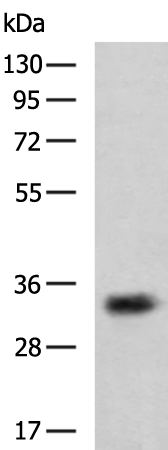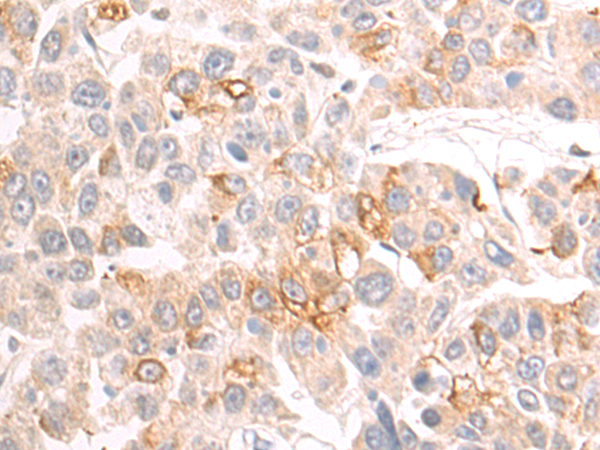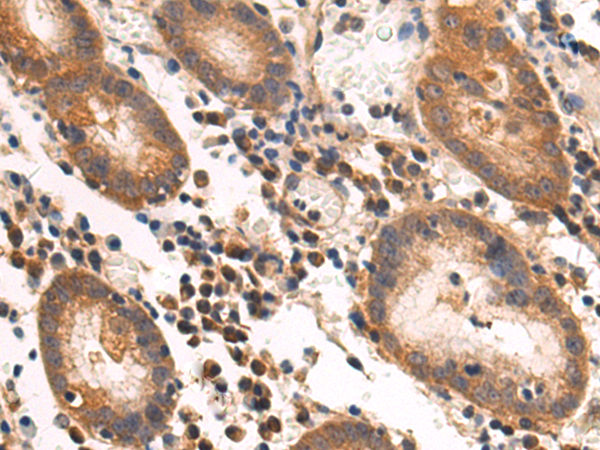


| WB | 咨询技术 | Human,Mouse,Rat |
| IF | 咨询技术 | Human,Mouse,Rat |
| IHC | 1/50-1/200 | Human,Mouse,Rat |
| ICC | 技术咨询 | Human,Mouse,Rat |
| FCM | 咨询技术 | Human,Mouse,Rat |
| Elisa | 1/5000-1/10000 | Human,Mouse,Rat |
| Aliases | CHIP; SCA48; UBOX1; SCAR16; HSPABP2; NY-CO-7; SDCCAG7 |
| WB Predicted band size | 35 kDa |
| Host/Isotype | Rabbit IgG |
| Antibody Type | Primary antibody |
| Storage | Store at 4°C short term. Aliquot and store at -20°C long term. Avoid freeze/thaw cycles. |
| Species Reactivity | Human, Mouse |
| Immunogen | Fusion protein of human STUB1 |
| Formulation | Purified antibody in PBS with 0.05% sodium azide and 50% glycerol. |
+ +
以下是关于STUB1抗体的参考文献示例(注:文献为示例性质,具体引用请核实真实来源):
---
1. **文献名称**:*CHIP/STUB1 functions as a dual regulator of heat shock proteins through its E3 ubiquitin ligase activity*
**作者**:Dai Q, et al.
**摘要**:该研究解析了STUB1(CHIP)作为E3泛素连接酶,通过调控HSP70和HSP90的稳定性参与蛋白质质量控制。实验利用STUB1抗体进行免疫共沉淀,证实其与分子伴侣的相互作用及泛素化功能。
2. **文献名称**:*STUB1 mutations in autosomal recessive spinocerebellar ataxia*
**作者**:Shi CH, et al.
**摘要**:研究揭示了STUB1基因突变导致隐性遗传性共济失调的机制。通过Western blot和免疫组化(使用STUB1抗体),发现突变体蛋白稳定性降低,影响小脑神经元中泛素-蛋白酶体通路。
3. **文献名称**:*STUB1 modulates tau pathology through regulation of HSP70 in Alzheimer's disease*
**作者**:Petrucelli L, et al.
**摘要**:探讨了STUB1通过泛素化降解HSP70.间接调控tau蛋白聚集的机制。研究利用STUB1抗体检测其在阿尔茨海默病模型中的表达变化,揭示其作为潜在治疗靶点。
4. **文献名称**:*STUB1 suppresses cancer progression by destabilizing oncogenic kinases*
**作者**:Wang J, et al.
**摘要**:发现STUB1通过靶向泛素化降解促癌激酶(如AKT),抑制肿瘤生长。免疫沉淀(使用STUB1抗体)证实其与激酶的直接结合,为癌症治疗提供新思路。
---
如需具体文献,建议通过PubMed或Google Scholar检索关键词“STUB1 antibody”、“CHIP ubiquitin ligase”等获取最新研究。
The STUB1 antibody targets the STUB1 protein, also known as CHIP (C-terminus of HSC70-interacting protein), an E3 ubiquitin ligase critical for cellular protein quality control. STUB1 facilitates ubiquitination of misfolded or damaged proteins, marking them for degradation via the ubiquitin-proteasome system. It interacts with molecular chaperones like Hsp70/Hsc70 and Hsp90. linking protein folding to degradation pathways. STUB1 is implicated in diverse physiological processes, including stress response, apoptosis, and neurodegeneration. Dysregulation of STUB1 is associated with neurological disorders (e.g., spinocerebellar ataxia, Alzheimer’s disease) and cancers, where it may act as a tumor suppressor or promoter depending on context.
Antibodies against STUB1 are widely used in research to detect its expression, localization, and interaction partners through techniques like Western blotting, immunohistochemistry, and immunoprecipitation. They help elucidate STUB1’s role in proteostasis, disease mechanisms, and therapeutic targeting. Commercial STUB1 antibodies vary in clonality (monoclonal/polyclonal), species reactivity, and epitope specificity, requiring validation for experimental conditions. Researchers often utilize these antibodies to study STUB1’s dual roles in protein degradation and cellular stress adaptation, offering insights into diseases linked to proteotoxic stress.
×